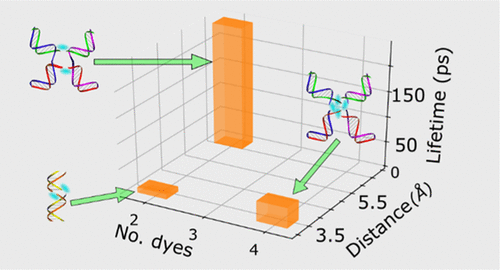当前位置:
X-MOL 学术
›
J. Phys. Chem. B
›
论文详情
Our official English website, www.x-mol.net, welcomes your feedback! (Note: you will need to create a separate account there.)
Excited-State Lifetimes of DNA-Templated Cyanine Dimer, Trimer, and Tetramer Aggregates: The Role of Exciton Delocalization, Dye Separation, and DNA Heterogeneity
The Journal of Physical Chemistry B ( IF 3.3 ) Pub Date : 2021-09-02 , DOI: 10.1021/acs.jpcb.1c04517 Jonathan S Huff 1 , Daniel B Turner 1 , Olga A Mass 1 , Lance K Patten 1 , Christopher K Wilson 1 , Simon K Roy 1 , Matthew S Barclay 1 , Bernard Yurke 1, 2 , William B Knowlton 1, 2 , Paul H Davis 1 , Ryan D Pensack 1
The Journal of Physical Chemistry B ( IF 3.3 ) Pub Date : 2021-09-02 , DOI: 10.1021/acs.jpcb.1c04517 Jonathan S Huff 1 , Daniel B Turner 1 , Olga A Mass 1 , Lance K Patten 1 , Christopher K Wilson 1 , Simon K Roy 1 , Matthew S Barclay 1 , Bernard Yurke 1, 2 , William B Knowlton 1, 2 , Paul H Davis 1 , Ryan D Pensack 1
Affiliation

|
DNA-templated molecular (dye) aggregates are a novel class of materials that have garnered attention in a broad range of areas including light harvesting, sensing, and computing. Using DNA to template dye aggregation is attractive due to the relative ease with which DNA nanostructures can be assembled in solution, the diverse array of nanostructures that can be assembled, and the ability to precisely position dyes to within a few Angstroms of one another. These factors, combined with the programmability of DNA, raise the prospect of designer materials custom tailored for specific applications. Although considerable progress has been made in characterizing the optical properties and associated electronic structures of these materials, less is known about their excited-state dynamics. For example, little is known about how the excited-state lifetime, a parameter essential to many applications, is influenced by structural factors, such as the number of dyes within the aggregate and their spatial arrangement. In this work, we use a combination of transient absorption spectroscopy and global target analysis to measure excited-state lifetimes in a series of DNA-templated cyanine dye aggregates. Specifically, we investigate six distinct dimer, trimer, and tetramer aggregates—based on the ubiquitous cyanine dye Cy5—templated using both duplex and Holliday junction DNA nanostructures. We find that these DNA-templated Cy5 aggregates all exhibit significantly reduced excited-state lifetimes, some by more than 2 orders of magnitude, and observe considerable variation among the lifetimes. We attribute the reduced excited-state lifetimes to enhanced nonradiative decay and proceed to discuss various structural factors, including exciton delocalization, dye separation, and DNA heterogeneity, that may contribute to the observed reduction and variability of excited-state lifetimes. Guided by insights from structural modeling, we find that the reduced lifetimes and enhanced nonradiative decay are most strongly correlated with the distance between the dyes. These results inform potential tradeoffs between dye separation, excitonic coupling strength, and excited-state lifetime that motivate deeper mechanistic understanding, potentially via further dye and dye template design.
中文翻译:

DNA 模板化花青二聚体、三聚体和四聚体聚集体的激发态寿命:激子离域、染料分离和 DNA 异质性的作用
DNA 模板分子(染料)聚集体是一类新型材料,在光收集、传感和计算等广泛领域引起了广泛关注。使用 DNA 作为模板染料聚集很有吸引力,因为 DNA 纳米结构可以相对容易地在溶液中组装,可以组装的纳米结构多种多样,并且能够将染料精确定位到彼此相距几埃的范围内。这些因素与 DNA 的可编程性相结合,提高了为特定应用定制的设计师材料的前景。尽管在表征这些材料的光学特性和相关电子结构方面取得了相当大的进展,但对其激发态动力学知之甚少。例如,人们对激发态寿命如何,知之甚少,许多应用中必不可少的参数受结构因素的影响,例如聚集体中染料的数量及其空间排列。在这项工作中,我们结合使用瞬态吸收光谱和全局目标分析来测量一系列 DNA 模板花青染料聚集体的激发态寿命。具体来说,我们研究了六种不同的二聚体、三聚体和四聚体聚集体——基于无处不在的花青染料 Cy5——使用双链和霍利迪连接 DNA 纳米结构作为模板。我们发现这些 DNA 模板化的 Cy5 聚集体都表现出显着降低的激发态寿命,有些降低了 2 个数量级以上,并且观察到寿命之间的相当大的变化。我们将减少的激发态寿命归因于增强的非辐射衰变,并继续讨论各种结构因素,包括激子离域、染料分离和 DNA 异质性,这些因素可能有助于观察到的激发态寿命的减少和可变性。在结构建模的见解的指导下,我们发现寿命缩短和非辐射衰减增强与染料之间的距离最密切相关。这些结果表明染料分离、激子耦合强度和激发态寿命之间的潜在权衡,可能通过进一步的染料和染料模板设计激发更深入的机制理解。这可能有助于观察到激发态寿命的减少和可变性。在结构建模的见解的指导下,我们发现寿命缩短和非辐射衰减增强与染料之间的距离最密切相关。这些结果表明染料分离、激子耦合强度和激发态寿命之间的潜在权衡,可能通过进一步的染料和染料模板设计激发更深入的机制理解。这可能有助于观察到激发态寿命的减少和可变性。在结构建模的见解的指导下,我们发现寿命缩短和非辐射衰减增强与染料之间的距离最密切相关。这些结果表明染料分离、激子耦合强度和激发态寿命之间的潜在权衡,可能通过进一步的染料和染料模板设计激发更深入的机制理解。
更新日期:2021-09-16
中文翻译:

DNA 模板化花青二聚体、三聚体和四聚体聚集体的激发态寿命:激子离域、染料分离和 DNA 异质性的作用
DNA 模板分子(染料)聚集体是一类新型材料,在光收集、传感和计算等广泛领域引起了广泛关注。使用 DNA 作为模板染料聚集很有吸引力,因为 DNA 纳米结构可以相对容易地在溶液中组装,可以组装的纳米结构多种多样,并且能够将染料精确定位到彼此相距几埃的范围内。这些因素与 DNA 的可编程性相结合,提高了为特定应用定制的设计师材料的前景。尽管在表征这些材料的光学特性和相关电子结构方面取得了相当大的进展,但对其激发态动力学知之甚少。例如,人们对激发态寿命如何,知之甚少,许多应用中必不可少的参数受结构因素的影响,例如聚集体中染料的数量及其空间排列。在这项工作中,我们结合使用瞬态吸收光谱和全局目标分析来测量一系列 DNA 模板花青染料聚集体的激发态寿命。具体来说,我们研究了六种不同的二聚体、三聚体和四聚体聚集体——基于无处不在的花青染料 Cy5——使用双链和霍利迪连接 DNA 纳米结构作为模板。我们发现这些 DNA 模板化的 Cy5 聚集体都表现出显着降低的激发态寿命,有些降低了 2 个数量级以上,并且观察到寿命之间的相当大的变化。我们将减少的激发态寿命归因于增强的非辐射衰变,并继续讨论各种结构因素,包括激子离域、染料分离和 DNA 异质性,这些因素可能有助于观察到的激发态寿命的减少和可变性。在结构建模的见解的指导下,我们发现寿命缩短和非辐射衰减增强与染料之间的距离最密切相关。这些结果表明染料分离、激子耦合强度和激发态寿命之间的潜在权衡,可能通过进一步的染料和染料模板设计激发更深入的机制理解。这可能有助于观察到激发态寿命的减少和可变性。在结构建模的见解的指导下,我们发现寿命缩短和非辐射衰减增强与染料之间的距离最密切相关。这些结果表明染料分离、激子耦合强度和激发态寿命之间的潜在权衡,可能通过进一步的染料和染料模板设计激发更深入的机制理解。这可能有助于观察到激发态寿命的减少和可变性。在结构建模的见解的指导下,我们发现寿命缩短和非辐射衰减增强与染料之间的距离最密切相关。这些结果表明染料分离、激子耦合强度和激发态寿命之间的潜在权衡,可能通过进一步的染料和染料模板设计激发更深入的机制理解。



























 京公网安备 11010802027423号
京公网安备 11010802027423号